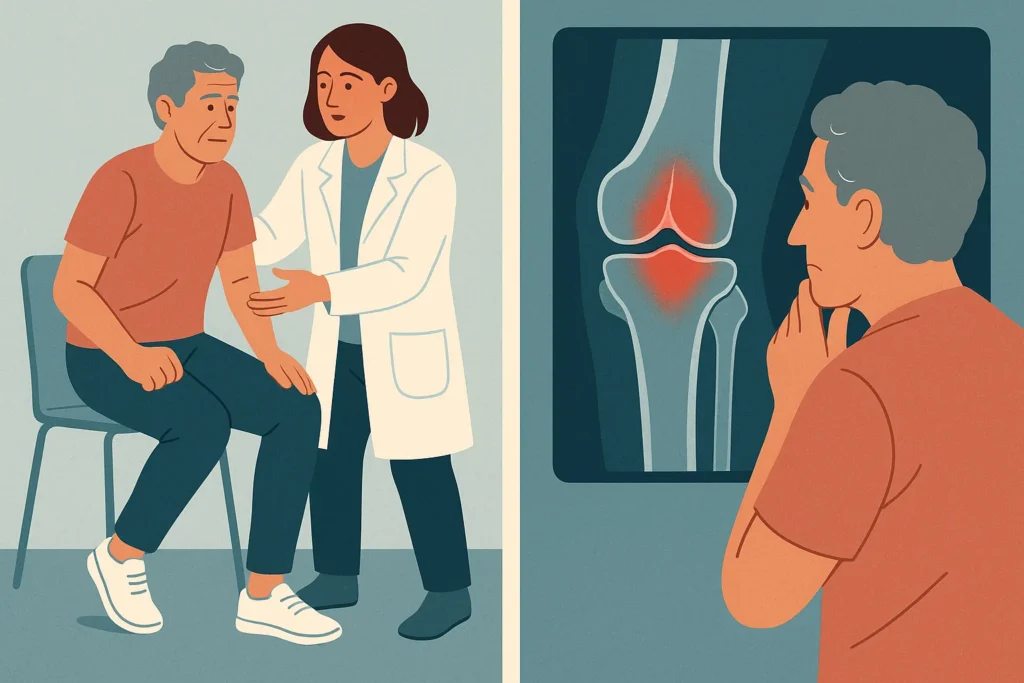Knee osteoarthritis (OA) is one of the most common causes of pain and disability in the world. While there is no cure, the cornerstone of effective management are exercise, physical activity, weight management, and medication where appropriate. Surgery, such as knee replacement, is usually only indicated for people with severe disease who cannot control their symptoms with non surgical means.
Yet, despite the use of international guidelines that recommend clinical diagnosis (based on age, symptoms, and physical examination) as opposed to X-rays, imaging is still widespread. Many patients also expect to see an x-ray when they see their doctor. Could this reliance on imaging affect how people think about their condition and the treatment they need?
A new randomised controlled trial, published in February 2025 in the journal PLOS Medicine, offers new insights. Researchers from the University of Melbourne and collaborating institutions tested if X-ray based explanations of the cause of knee OA change patient beliefs of surgery, exercise and prognosis.
Why the Study Was Done
The motivation for this trial is based on two important trends:
Low uptake of exercise: Exercise is one of the most effective ways to manage OA and many patients remain reluctant to engage in this.
High use of surgery: Joint replacements are increasing worldwide, even in people who could probably benefit from non surgical approaches.
Researchers suspected that patient beliefs about OA particularly influenced by approaches to diagnosis might be driving this imbalance. For example, viewing an X-ray that points out damage could confirm the belief that surgery is inevitable and discourage exercise.
How the Study Worked
The trial was a sample of 617 adults through out Australia aged 45 and older. Participants were given a hypothetical scenario: they had knee pain for six months and were consulting a general practitioner (GP).
They were randomly assigned to one of three groups, each of which watched a two minute video of a GP explaining their diagnosis:
Clinical explanation only (no x-ray)
Radiographic explanation (X-ray taken and images not shown)
Explanation by radiograph (X-ray taken and images shown)
The videos included information on OA, prognosis and suggested management. The researchers then measured participant’s beliefs about:
Need for joint replacement surgery
Helpfulness of exercising and physical activity
Secondary measures were beliefs about medication, fear of movement, fear of worsening symptoms and satisfaction with the consultation
Key Findings
The results were striking:
Belief in surgery brought increase with X-rays
Participants who viewed X-ray images were more likely to think surgery was needed (average rating 4.5 out of 10) than participants given just a clinical explanation (3.3 out of 10).
This difference was above the pre determined threshold to be clinically significant.
Exercise beliefs remained the same
Across all groups, participants judged exercise and physical activity to be helpful (average 7.5-7.9 out of 10).
X-ray use didn’t lower belief in the value of exercise.
Secondary beliefs turned unfavorably with X-rays
Those who saw X-rays were more likely to believe exercise could damage their knee.
They were also more worried about their knee problem getting worse and also reported increased fear of movement.
Higher satisfaction with X-ray explanations
Interestingly, those participants who received radiographic explanations were found more satisfied with their GP consultation and more confident in the diagnosis, despite their beliefs moving towards surgery.
What Do These Results Mean?
This study offers the first causal evidence that use of X-rays for the diagnosis and explanation of knee OA can inadvertently affect patient beliefs in a manner that is likely to promote overuse of surgery.
Clinical diagnosis is safer for beliefs: When GPs only used clinical signs and symptoms to explain OA, patients were less likely to think surgery was inevitable.
X-rays reinforce structural thinking: Seeing narrowed joint space or bony spurs may cause patients to see their joints as “damaged” and fragile and this fuels misconceptions.
Patient reassurance is complicated: Although X-rays enabled patients to be more confident in the diagnosis, they also fostered beliefs that may interfere with evidence based self management.
Why It’s Important to Healthcare
Over 1.2 million joint replacements are performed annually in the United States alone and cost about $20 billion. With surgery rates expected to increase, changing patient beliefs to non surgical care that works could help reduce unnecessary surgeries
This study shows the importance of communication in health care:
Doctors may need to rethink the way they explain OA, without defaulting to imaging.
Educational resources should avoid overly biomedical language that focuses on damage as opposed to holistic joint health.
Strategies such as reframing the X-ray reports with context (such as telling patients that many healthy adults have similar changes) could help.

Limitations
There were some constraints in the study:
Participants were asked to respond to a hypothetical scenario and not a real consultation.
It’s unclear whether these changes in beliefs would be reflected in real world treatment decisions.
Only English speaking Australians without previous OA consultations were included, so generalizability may be limited.
Still, the findings do offer a critical first step in understanding how diagnostic approaches can shape patient mindsets.
Conclusion
This landmark study shows that the way that osteoarthritis is diagnosed is important. While patients may be reassured by X-rays, they also come away feeling that surgery is more necessary and exercise may be riskier. Clinical diagnosis, on the other hand, advances healthier, guideline based beliefs.
For healthcare providers, the lesson is clear use X-rays only when it is truly necessary, and focus on communication that empowers patients with evidence based strategies such as exercise and self management.
Reference
Lawford BJ, Bennell KL, Ewald D, Li P, De Silva A, Pardo J, et al. Effects of X-ray based diagnosis and explanation of knee osteoarthritis on patient beliefs about osteoarthritis management: A randomised clinical trial. PLOS Medicine. 2025;22(2):e1004537. doi:10.1371/journal.pmed.1004537

